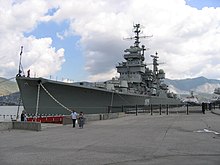Light cruiser
The light cruiser is a 20th century warship type.
Typology
The light cruiser emerged from the small cruiser . "Light" does not refer to the water displacement , but to the gun caliber of the main armament, which is 15 cm - well below the upper caliber limit of 20.3 cm for cruisers set at the Washington Naval Conference in 1922. It was not until the fleet conference in London in 1930 that the light cruiser with an upper caliber limit of 15.5 cm was defined as a separate type of ship. The 1936 London Fleet Agreement finally set a tonnage limit of 8,000 tn.l. firmly.
Even before the Washington Fleet Conference, the Royal Navy was already familiar with the classification as a "light cruiser", for example with the cruisers of the Town class . The name was derived from "Light Armored Cruiser" ("light armored cruiser "), because the ships, like the earlier armored cruisers, with which they had nothing else in common, had vertical armor protection along the waterline .
Light cruisers were also built for countries that were not bound by treaty: Argentina , the German Empire , the Netherlands and Spain .
Purposes
Light cruisers should fight battles with enemy ships of the same size, repel destroyer and torpedo boat attacks, fight coastal targets, wage trade wars or serve as lead ships for their own destroyer squadrons. In addition, they should take on the classic educational tasks. Because of the growing importance of the Luftwaffe , light cruisers received increased anti-aircraft armament in the 1930s . Specialized forms of these ships also emerged: The Royal Navy and the US Navy developed cruisers, which received anti-aircraft multi-purpose guns from 12.7–13.3 cm as their main armament and were later also referred to as anti-aircraft cruisers . The Japanese Navy converted several units to torpedo cruisers . In order to be able to operate in association with destroyers, the ships had very high speeds; the Italian light cruisers of the Alberto di Giussano class even ran up to 42 knots (approx. 77 km / h) during their tests .
Further development
The armaments efforts before and during the Second World War meant that the limits set by the naval conferences were no longer observed. By 1945, light cruisers had a displacement of over 15,000 tons and armor that was considerable for their size. On the other hand, however, there were also particularly light and fast light cruisers that had very little armor protection and were designed more like a large destroyer , but were never clearly classified as such.
After the introduction of airborne missiles , the light cruisers with their tube artillery increasingly lost their importance. They were either converted into guided missile cruisers or missile cruisers, or they were decommissioned. Over thirty light cruisers were built for the US Navy during World War II, almost all of which survived the war. These relatively new and unused ships were, if they were not included in the conversion program, placed in reserve status and “mothballed”. Therefore, the even older pre-war light cruisers were retired and some were sold to Argentina and Brazil .
Only a few light cruisers were built after 1945, for example by the Soviet Navy . Few remained in service and mostly served as training ships .
Curiosities
During the First World War , the Royal Navy had three large warships of around 20,000 tn.l. that were intended for use in the Baltic Sea ( Furious , Courageous and Glorious ). The Furious was to be armed with two 18-inch (45.7 cm) guns in single turrets , while the other two received four 15-inch (38.1 cm) guns in two twin turrets. The armor was minimal. They received the classification of Large light Cruisers , but were more like light battle cruisers . They turned out to be faulty designs and were soon converted into aircraft carriers .
Light cruiser De Ruyter of the Dutch Navy (1936–1942)
Light cruiser HMS Belfast of the British Royal Navy (now a museum ship on the Thames in London)
The USS San Diego , a US Navy anti-aircraft cruiser



